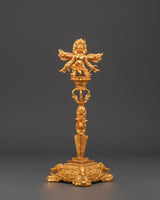
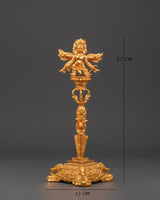
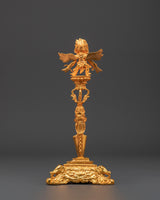
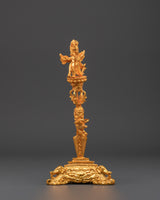
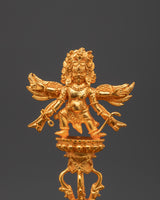
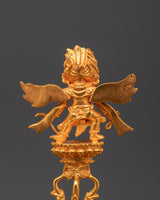
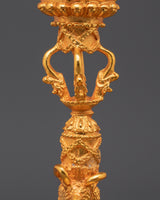

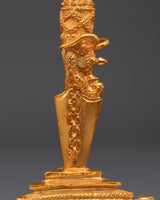


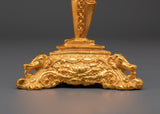
Traditional Buddhist Ritual Phurba Dagger | Spiritual Artifact

100% AUTHENTIC

HANDMADE

FREE SHIPPING
Traditional Buddhist Ritual Phurba Dagger | Gold Plated with Intricate Details
--------------------------------------------
Size: 27cm(Height) x 13cm(Width)
Weight: 0.85kg
Materials: Copper, Gold Plated
--------------------------------------------
About The Ritual Item :
The Traditional Buddhist Ritual Phurba Dagger is a sacred instrument filled with spiritual symbolism that is used in Vajrayana and Tantric Buddhist activities. This Phurba is 27cm tall and 13cm broad, made of copper and gold-plated, which adds to its holy vitality and beautiful appeal. Traditionally connected with the wrathful deity Vajrakilaya, the Phurba dagger is said to eliminate negativity, destroy inner impediments, and channel protecting spiritual forces during ceremonial rites.
This exquisitely crafted Phurba dagger embodies Himalayan spiritual dedication, with every element from the fierce deity’s visage to the triple-edged blade representing triumph over ignorance, attachment, and aversion. Made of copper for enhanced energy flow and finished with gold plating to evoke divine energy, abundance, and transformation, it serves as a potent tool for Tantric practitioners. Perfect for rituals or display, this gold-plated dagger complements altars, meditation spaces, and temples. Weighing 0.85kg with balanced proportions, it’s ideal for ceremonial use and acts as a powerful symbol of spiritual focus, protection, and intention amplification.
Introduction To The Phurba :
The ceremonial dagger (Sanskrit: Kila; Tibetan: phurba) is essential for expelling evil and is considered especially effective in neutralizing the forces obstructing Tantric Buddhist practice. It has ancient origins, first appearing in the Indian Rg Veda as the core blade of the vajra used by Indra to destroy the primordial cosmic snake Vritra. Kila, a peg or stake in Sanskrit, was most likely associated with Vedic sacrifices. Meditation on the Vajrakila Tantra, an early Indian scripture first promoted in Tibet in the eighth century by Padmasambhava, one of the founding teachers of Tibetan Buddhism, is used to invoke the three-headed Vajrakila Buddha.
How to set up your own Buddhist Shrine?
Find a clean, quiet, and uncluttered spot
Set up an altar table, and cover it with an altar cloth that calls to you
Place your sacred item (statue, thangka, or a picture of Buddha) at the center






















